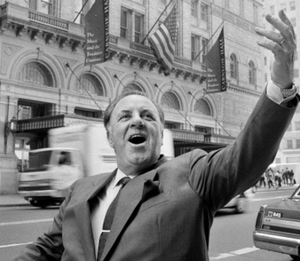Carlo Bergonzi (tenor) facts for kids
Carlo Bergonzi (July 13, 1924 – July 25, 2014) was a famous Italian opera singer. He was a tenor, which is a high male singing voice. He was especially known for singing in operas by Giuseppe Verdi. He also helped bring back some of Verdi's less known works. Throughout his career, he sang more than forty different roles.
Contents
About Carlo Bergonzi
His Early Life
Carlo Bergonzi was born in a small town called Polesine Parmense, near Parma, Italy, on July 13, 1924. When he was six, he saw his first opera and loved it! He started singing in church and soon performed in children's operas in a nearby town.
When he was 11, he started working in a cheese factory. He often got into trouble for singing while he worked. At 16, he began studying singing seriously at a music school in Parma. He first trained as a baritone, which is a middle-range male singing voice.
During World War II, Carlo helped fight against bad guys. He was captured and held in a prisoner-of-war camp for two years. After he was freed, he got very sick but recovered within a year. He then went back to his music studies.
Becoming an Opera Star
Carlo Bergonzi started his professional singing career in 1948 as a baritone. He sang the role of Figaro in The Barber of Seville. He soon realized that his voice was better suited for tenor roles. After more training, he made his debut as a tenor in 1951. This was in the opera Andrea Chénier in Bari, Italy.
That same year, he sang in a special concert for Verdi's 50th death anniversary. The Italian radio network also hired him to sing in many of Verdi's less famous operas.
In 1953, Bergonzi sang for the first time at La Scala, a very famous opera house in Milan, Italy. He made his debut in London later that year. In 1955, he sang in America for the first time in Chicago. His first performance at the Metropolitan Opera in New York City was in 1956. He sang there for 32 years! His last performance at the Met was in 1988.
Carlo Bergonzi had a very busy career in the 1960s. He performed all over the world and made many recordings. He continued to sing through the 1970s. In the 1980s, as he got older, he focused more on concerts. In 1996, he gave his farewell concert in America at Carnegie Hall.
In 2000, he tried to sing the main role in Verdi's Otello in a concert. This was a very difficult role he had never performed on stage. Many famous singers were in the audience. However, he couldn't finish the performance and had to leave after two acts.
After he retired, Carlo Bergonzi became a teacher. He helped many young singers learn how to sing opera.
His Amazing Voice
People often said that Carlo Bergonzi had a very special way of singing. He was a natural singer. He knew how to shape the music beautifully and use his voice to show different feelings. He was praised for his clear words and how he made every note sound just right. Critics said he sang with his heart, not just his mind. His singing was described as "exactly how the music ought to sound."
His Family Life
In 1950, Carlo Bergonzi married Adele Aimi. They had two sons, Maurizio and Marco. Maurizio was born on the same day Carlo made his debut as a tenor! Carlo owned homes in Milan and Busseto. He also owned a restaurant and hotel in Busseto, named "I Due Foscari" after a Verdi opera.
Carlo Bergonzi passed away on July 25, 2014, shortly after his 90th birthday. He was buried in Italy.
Operas Carlo Bergonzi Sang (as a Tenor)
- Andrea Chénier. Bari, 1951
- Giovanna d'Arco. Milan, 1951
- Pagliacci. Milan, 1951
- La forza del destino. Milan, 1951
- Un ballo in maschera. Milan, 1951
- Simon Boccanegra. Rome, 1951
- I due Foscari. Milan, 1951
- Adriana Lecouvreur. Prato, 1951
- Faust. Bari, 1952
- Jenůfa (Steva). Rome, 1952
- Ifigenia (by Pizzetti). Naples, 1952
- Mefistofele. Rome, 1952
- Madama Butterfly. Cagliari, 1952
- Mas' Aniello. Milan, 1953
- Rigoletto. Livorno, 1953
- Aida. Buenos Aires, 1953
- Tosca. Buenos Aires, 1953
- Manon Lescaut. Rovigo, 1953
- Turandot. Catania, 1953
- Loreley. Reggio Emilia, 1954
- L'incoronazione di Poppea. Milan, 1954
- Carmen. Monte Carlo, 1955
- Lucia di Lammermoor. Brescia, 1955
- Don Carlos. Buenos Aires, 1955
- La traviata. Salsomaggiore, 1955
- Il tabarro. Chicago, 1955
- Cavalleria rusticana. Chicago, 1955
- L'amore dei tre re. Chicago, 1955
- La Gioconda. Trieste, 1956
- Il trovatore. New York, 1956
- Fior di Maria. Milan, 1957
- La bohème. Caracas, 1957
- Macbeth. New York, 1959
- L'elisir d'amore. San Sebastian, 1959
- Ernani. New York, 1962
- La Wally. New York, 1968
- Werther. Naples, 1969
- Aida. Parma, date unk.
- La forza del destino. Parma, date unk.
- Norma. New York, 1970
- Luisa Miller. Genoa, 1972
- Edgar. New York, 1977
- I Lombardi alla prima crociata. San Diego, 1979
- Il corsaro. New York, 1981
- Attila. Tulsa, 1982
- Oberto. Munich, 1983
- Otello - acts 1 and 2. New York, 2000
Videography
- James Levine's 25th Anniversary Metropolitan Opera Gala (1996), a DVD recording.
Honors
 Italy: Knight Grand Cross of the Order of Merit of the Italian Republic (2011)
Italy: Knight Grand Cross of the Order of Merit of the Italian Republic (2011)
See also
 In Spanish: Carlo Bergonzi para niños
In Spanish: Carlo Bergonzi para niños


